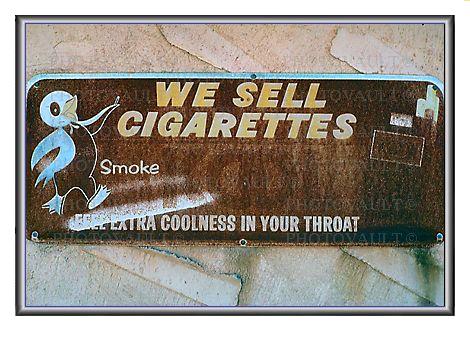Section I: Market Description

The 20th Century King – A History of the Cigarette
by Ryan Pensack
![]()

![]()
The first known use of tobacco roots itself with the Native Americans, specifically the Mayan civilization in Central America during the first century BC, who used the plant in religious rituals (Parker-Pope 6). It was used in many forms, including chewing it and smoking it in pipes, wrapped in leaves (as in a cigar), or wrapped in reeds (as in a cigarette). The first time Europeans became aware of the plant was when Columbus and his men came back from his first voyage. The natives had given them the strange plant and the sailors had spied how they smoked it. Due to English explorers such as Sir Walter Raleigh, perhaps the first agents of advertising for tobacco, pipe smoking became fairly popular in Europe for the next two centuries. The Europeans interest increased even further after an intriguing statement by the French Ambassador, Jean Nicot. He considered the plant a marvelous “Indian” herb which “proved valuable against [ailments] given up as incurable by the physicians (Parker-Pope 2-3).” This led people to believe that the plant was a “wonder drug.” For instance, during the plague, one fellow was beaten by his teachers for not smoking during his break. However, King James I of England probably had one of the first anti-smoking ads with his 1604 piece, A Counteblaste to Tobacco, in which he scoffs at the idea of the “wonder drug” and berates smokers (A Counteblaste to Tobacco). In other parts of the world, such as China and Turkey, people who used tobacco were actually put to death (Cordry 2).
In North America, tobacco became a highly profitable cash drop in the 17th century with the introduction of a Caribbean species to Jamestown by John Rolfe (John Rolfe). The crop became a valuable export crop playing a very large role in the economy of the southern states. As for its use, chewing tobacco dominated in North America, however, pipe smoking was common and fine cigars were “considered to be quite a status symbol (Tips for Tobacco Users: Tobacco Use During the Civil War).”





Two key elements kept the cigarette from being the most popular form of using tobacco prior to the 20th century. First of all, technology hindered its mass production up until 1884, when W. Duke & Sons leased two devices that pumped out 200 cigarettes a minute. With this technology and increased advertising efforts, the owner was able to hold a monopoly on the cigarette industry by 1890, gaining control of 90 percent of the cigarette market in the nation (Cultivation of a Tobacco Empire). However, just as John D. Rockefeller was ordered to dismantle his oil empire in 1911 under the Sherman Act, W. Duke & Sons were ordered to dismantle their company, called the American Tobacco Company. Four major companies were spawned after this dissolution including American Tobacco Company, R.J. Reynolds (Camel), Lorillard (Newport), and Liggett & Myers (L & M).
The second factor that contributed to the popularity of the cigarette in the 20th century was a change in social attitudes towards its consumption. The primary view before the 20th century was that cigarettes were suitable only for “the poor and ‘so weak-tasting as to invite the suspicion that those smokers who preferred… [them] were effeminate’ (Cordry 3).” However, this attitude changed after World War I. This was a war in which General George Pershing had appealed to the War Department to keep U.S. troops adequately supplied with cigarettes, which he said were “no less important than bullets (Cordry 3).” Also, during World War II, President Franklin D. Roosevelt legitimized smoking by declaring tobacco an essential wartime crop (Parker-Pope 15). The cigarette was considered effective and efficient enough for use during war. They are compact, relatively clean, and easy to share in the trenches and they also steady the nerves (Parker-Pope 14). “Cigarettes calm, they comfort, they give pleasure,” writes Donald Gould in the New Scientist. “They act as a kind of stockade, a visible barrier between the naked individual and a hostile perplexing world.” As soldiers returned home, they brought their addiction with them and cigarette consumption proliferated. Women, who did not chew or smoke pipes as it was not socially acceptable, began smoking cigarettes. The cigarette companies further increased their market through advertisements and endorsements. It would also be valuable to mention that Hollywood has been attacked vehemently for its role in the increase in the appeal of cigarettes.
However, the first report on tobacco from the U.S. Surgeon General which came in 1964 quickly ended anymore blind increase in demand for cigarettes. There was an increasing trend in the mid-19th century to get the message out that cigarettes are scientifically proven to be harmful. As evidence for this fact arose, the golden era of the cigarette was evidently over. People started buying less because they didn’t want to die of cancer or heart disease. The cigarette companies have now turned to less hostile markets in developing countries to counterbalance the decrease in consumption in America (Cordry 55).
Another interesting factor of this market to make note of is the recent tax hike on cigarettes in some areas, particularly in the northeast. For example, in New York City, recent taxes reach up to $3.00 per pack (the highest in the country). A black market has risen in this area that “has diverted billions of dollars from legitimate businesses and the government to criminals (Cigarette Taxes, Black Markets, and Crime Lessons from New York’s 50-Year Losing Battle ).” There is also supposedly an increase in crime associated with the city’s illegal market, too. The black market is comprised off moving large scale amounts of cigarettes from areas of low tax (ex. North Caroline) to the city, where a profit can be made.
© 2003 [email protected]